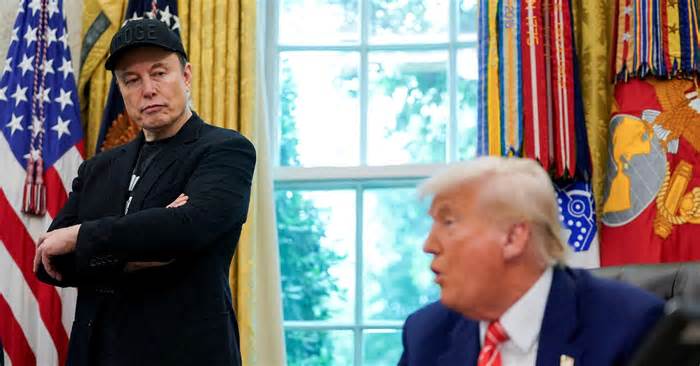
Musk's Starlink Set for India Launch: Pricing and How it Works Explained
- by NDTV 24x7 on MSN.com
- Jun 07, 2025
- 0 Comments
- 0 Likes Flag 0 Of 5

Elon Musk
New Delhi: Elon Musk's Starlink has received a licence from the telecom department for providing satellite internet services in India, a key milestone that will take it closer towards launching commercial operations in the country.
Starlink is the third company after Eutelsat OneWeb and Jio Satellite Communications to get a licence from the Department of Telecommunications to provide satellite internet services in the country.
A fourth applicant, Amazon's Kuiper is still waiting for approvals.
DoT sources confirmed on Friday that Starlink has indeed received the licence, and said the company will be granted trial spectrum in 15-20 days of applying for it.
Starlink will now have to comply with the security norms such as providing access for lawful interception, before starting services.
What is Starlink, How it works:
Starlink is a satellite internet service developed by SpaceX -- the American aerospace manufacturer and space transportation company founded in 2002 by the world's richest man Musk. It provides high-speed, low-latency broadband internet worldwide using satellite technology and is aptly described by some as broadband beamed from the skies.
Unlike conventional satellite services that rely on distant geostationary satellites, Starlink utilises the world's largest low Earth orbit or LEO constellation (550 km above Earth).
This constellation of LEO satellites (7,000 now but eventually set to grow to over 40,000) and its mesh delivers broadband internet capable of supporting streaming, online gaming, and video calls.
Starlink, which had been vying for an India licence for some time now, recently signed pacts with Ambani's Reliance Jio and Mittal's Bharti Airtel, which together control more than 70 per cent of the country's telecom market, to bring the US satellite internet giant's services to India.
The nod for the satcom offering -- known for its resilience in harsh conditions and conflict zones -- coincides with escalation of Donald Trump-Elon Musk feud in the US.
Pricing:
Pricing is expected to be in a premium range, with a basic plan at around Rs850/month for 50GB and Rs2.500 Rs3,400/month for unlimited data. User equipment costs, ranging from Rs21,000 to Rs43,000, may pose challenges for adoption in rural areas without subsidies. Urban and metro areas are likely to see low uptake due to the availability of low-cost fibre broadband options.
However, Starlink's presence is not expected to disrupt existing ISPs or mobile operators in the near term, but rather add value by addressing India's digital access gaps.
Due to high terminal and plan costs, it is likely to remain a premium offering focused on specific use cases, rather than widespread consumer adoption. Long-term expansion and cost reductions, coupled with a favourable regulatory framework, could enable broader impact.
Licence in India
The licence came hours after a huge public spat between Musk and US President Donald Trump. The falling-out between the world's richest man and the world's most powerful person began when Musk, who left his role as head of the Department of Government Efficiency a week ago, denounced Trump's sweeping tax-cut and spending bill.
On Thursday, it erupted in the verbal duel after Trump criticised Musk in the Oval Office. Musk responded saying "Trump would have lost" without his help, prompting the US President to end US contracts.
The licence from DoT came nearly a month after the Starlink was issued a letter of intent (LoI) by the telecom department.
The companies that have received the licence would, however, have to a wait a tad longer for commercial satcom spectrum as the TRAI just recently sent its recommendations on pricing, and terms and conditions, to the government for its consideration.
The players will be able to start their services after the allocation of radio wave frequencies.
Typically, even before the commercial spectrum, the trial spectrum is required to test, and verify the systems and processes on security parameters to demonstrate that all norms and requirements, are being complied with.
The status of the Starlink's final nod from the Indian space regulator, In-SPACe could not be immediately ascertained.
Security norms for satellite communication services
Early last month, the government had issued stringent security norms mandating legal interception of satellite communication services and barred companies from linking connection of users in any form with any terminal or facility located outside the country's border as well as processing of their data overseas.
The tighter security rules also mandate service providers to indigenise at least 20 per cent of their ground segment of the satellite network within years of their establishment in the country. The satcom service licence holders will require security clearances for specific gateway and hub locations in India and compliance to monitoring, interception facilities and equipment requirements.
India's rules mandate satcom firms to demonstrate system capabilities with respect to security aspects, including monitoring, to the Department of Telecom (DoT) or its authorised representatives before starting operations in India.
It is pertinent to mention that Telecom regulator TRAI last month recommended that satellite communication companies like Starlink pay 4 per cent of their adjusted gross revenue (AGR) as spectrum charges to the government -- a rate steeper than what these firms had been lobbying for.
Operators offering satellite-based broadband internet services in urban areas would have to shell out an additional Rs 500 per subscribers annually, TRAI recommended. No additional levy would be applicable for services in rural areas.
COAI, whose members include Reliance Jio and Airtel, recently approached the telecom department to raise concerns over TRAI recommendations on the satcom spectrum.
The industry body argued that "incorrect assumptions" have led to unjustifiably low spectrum charges for satellite services relative to terrestrial networks -- a claim strongly rejected by Trai, which has ruled out any review of recommendations at this stage, based on industry body COAI's charges.
Impact on India
According to the recent report by Centrum, it believes that SpaceX's satellite internet division, Starlink, is not positioned to compete directly with major telecom operators like Reliance Jio, Airtel, or VIL.
The reports say that instead of this, Starlink is strategically positioned to complement India's existing connectivity landscape, specifically targeting remote and hard-to-reach areas where traditional network infrastructure is currently unviable.
Starlink is preparing for its highly anticipated launch in India following conditional approvals from the Department of Telecommunications (DoT). This significant regulatory stride, marked by a Letter of Intent (Lol), enables Starlink to operate under stringent compliance and localisation mandates
Centrum says that this initial network capacity is estimated to serve approximately 50,000 users at launch. Even with projected improvements, a total bandwidth of 3 Tbps by 2027 will restrict usage to select high need zones and high-tiered plans.
( Source : Deccan Chronicle with agency inputs )
Please first to comment
Related Post
Stay Connected
Tweets by elonmuskTo get the latest tweets please make sure you are logged in on X on this browser.






 Energy
Energy


















